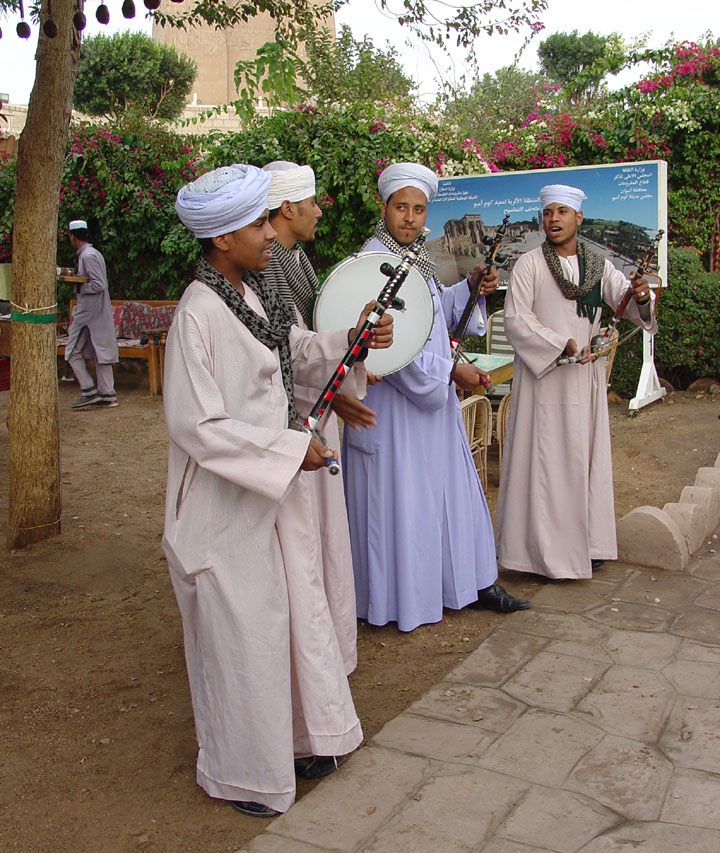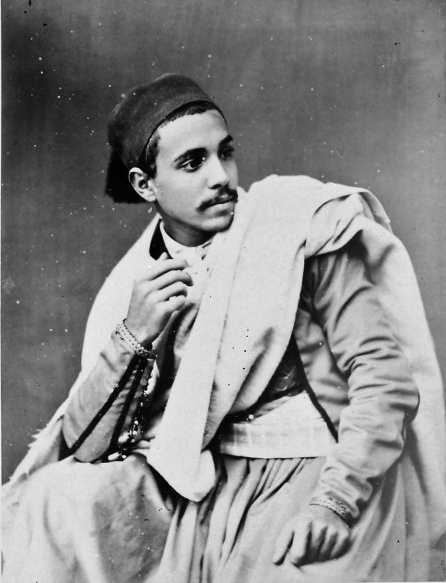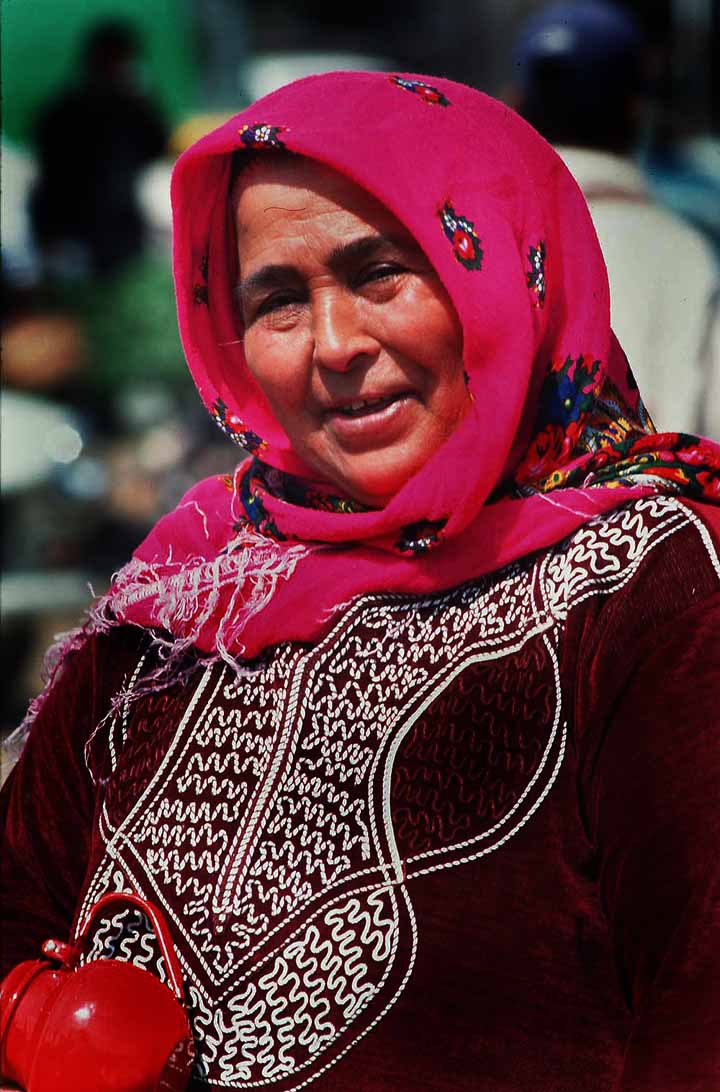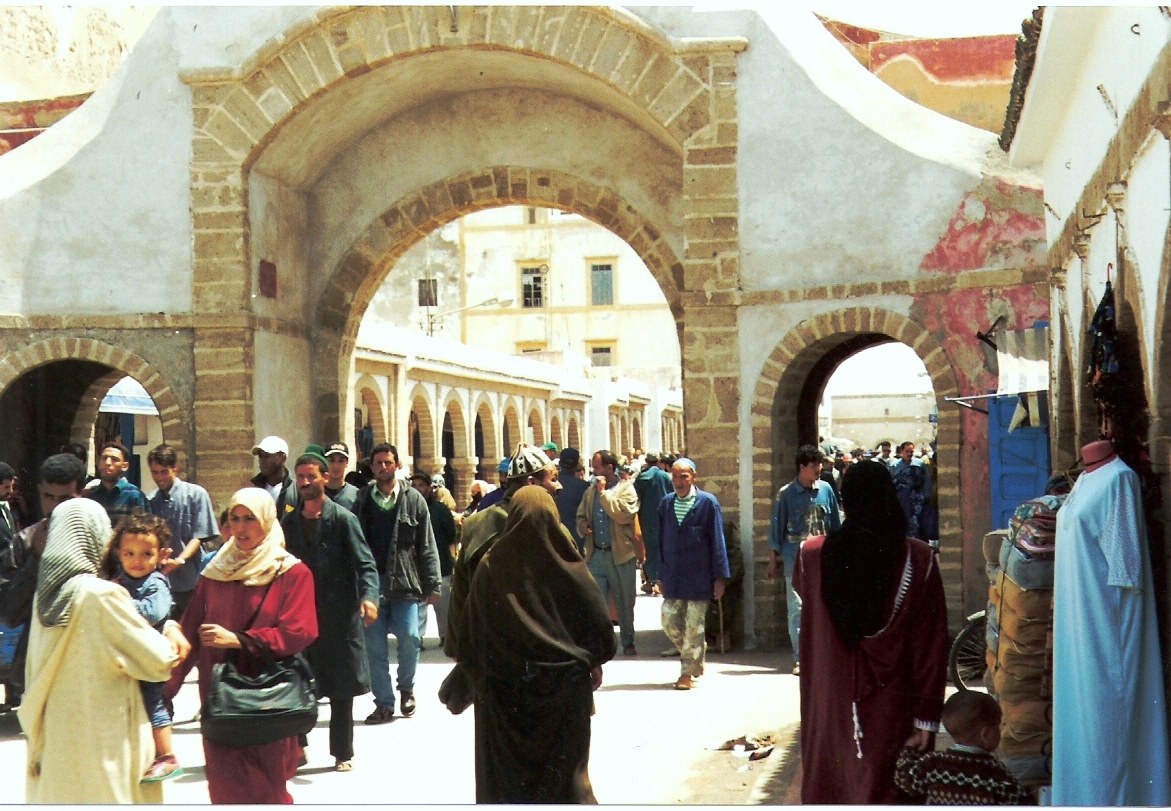|
Jellabiya
The jellabiya, also jalabiya or galabeya ( ar, جلابية / ALA-LC: ', Egyptian Arabic, Egyptian slang: Galabyia, ; "jelebeeya" in Ethiopia; "jehllubeeya" in Eritrea) is a loose-fitting, traditional Egyptian garment from the Nile Valley. Today, it is associated with farmers living in the Republic of Egypt (Giza-Cairo, Luxor, and Aswan) and comes in rich color varieties. The garment is also worn in Sudan, but has other textures and is usually white, as well as some communities from Eritrea and Ethiopia. The colorful Egyptian style is used by both men and women. The jellabiya differs from the Arabic thawb, as it has a wider cut, no collar (in some cases, no buttons) and longer, wider sleeves. Versions for farmers have very wide sleeves and sewn-in pockets used to carry tobacco, money, or other small items. Along the Red Sea coast in Egypt, Nubia and Sudan and among Beja people, Beja tribesmen, the Arabic dishdash is preferred due to the jellabiya's relation to farming. Jellabiya ... [...More Info...] [...Related Items...] OR: [Wikipedia] [Google] [Baidu] |
Thawb
Thawb ( ar, ثَوْب "garment"), also spelled thobe or tobe and known by various other names in different regions, is an ankle-length robe, usually with long sleeves. It is commonly worn in the Arabian Peninsula, the Middle East, North Africa, and other neighbouring Arab countries, and some countries in East and West Africa. Etymology The word ''thawb'' (ثَوْب) is the Arabic word for "garment". It is also romanized as ''thobe'' or ''thaub''. Prevalence and regional differences in names and use by gender Middle East and North Africa The ''thawb'' is commonly worn by men in the Arabian Peninsula. It is normally made of cotton, but heavier materials such as sheep's wool can also be used, especially in colder climates in Iraq and Syria. The style of the thawb varies slightly among the various regions in the area. The sleeves and the collar can be stiffened to give a more formal appearance. Other names may be used for this garment. In Iraq, Kuwait, the Levant, and Oman, ... [...More Info...] [...Related Items...] OR: [Wikipedia] [Google] [Baidu] |
Dishdash
Thawb ( ar, ثَوْب "garment"), also spelled thobe or tobe and known by various other names in different regions, is an ankle-length robe, usually with long sleeves. It is commonly worn in the Arabian Peninsula, the Middle East, North Africa, and other neighbouring Arab countries, and some countries in East and West Africa. Etymology The word ''thawb'' (ثَوْب) is the Arabic word for "garment". It is also romanized as ''thobe'' or ''thaub''. Prevalence and regional differences in names and use by gender Middle East and North Africa The ''thawb'' is commonly worn by men in the Arabian Peninsula. It is normally made of cotton, but heavier materials such as sheep's wool can also be used, especially in colder climates in Iraq and Syria. The style of the thawb varies slightly among the various regions in the area. The sleeves and the collar can be stiffened to give a more formal appearance. Other names may be used for this garment. In Iraq, Kuwait, the Levant, and Oman, ... [...More Info...] [...Related Items...] OR: [Wikipedia] [Google] [Baidu] |
Thawb
Thawb ( ar, ثَوْب "garment"), also spelled thobe or tobe and known by various other names in different regions, is an ankle-length robe, usually with long sleeves. It is commonly worn in the Arabian Peninsula, the Middle East, North Africa, and other neighbouring Arab countries, and some countries in East and West Africa. Etymology The word ''thawb'' (ثَوْب) is the Arabic word for "garment". It is also romanized as ''thobe'' or ''thaub''. Prevalence and regional differences in names and use by gender Middle East and North Africa The ''thawb'' is commonly worn by men in the Arabian Peninsula. It is normally made of cotton, but heavier materials such as sheep's wool can also be used, especially in colder climates in Iraq and Syria. The style of the thawb varies slightly among the various regions in the area. The sleeves and the collar can be stiffened to give a more formal appearance. Other names may be used for this garment. In Iraq, Kuwait, the Levant, and Oman, ... [...More Info...] [...Related Items...] OR: [Wikipedia] [Google] [Baidu] |
Djellaba
The djellaba or jillaba (; Arabic: جلابة; Berber: ''aselham''), also written gallabea, is a long, loose-fitting unisex outer robe with full sleeves that is worn in the Maghreb region of North Africa. In central and eastern Algeria it is called ''qeššaba'' or ''qeššabiya''. The mountain dwellers of Morocco call it ''tadjellabit'', which is a Berberized form. Etymology Reinhart Dozy's theory that the Djellaba would have been, originally, the "garment of the Djellab", that is to say of the slave trader, has been rejected by William Marçais who proposed to see in djellaba an alteration of djilbab which, in ancient Arabic, meant draped clothing, although the djellaba is sewn rather than draped. He pointed out that in Oman the form ''gillab'' designates the woman's veil. The disappearance of the first ''b'' would have occurred identically in the Maghreb and Oman. As for the qeššabiya, Georges Séraphin Colin sees in this name the deformation of the Latin ''gausapa'', a te ... [...More Info...] [...Related Items...] OR: [Wikipedia] [Google] [Baidu] |
Ammama
Ammama or 'Emma (Arabic: عمامة; Egyptian Arabic: عمة IPA: �ʕem.mæor AMMĀMA, Arabic ʿEMĀMA) is a type of turban that is religiously significant to Muslims. Men in Egypt Egypt ( ar, مصر , ), officially the Arab Republic of Egypt, is a transcontinental country spanning the northeast corner of Africa and southwest corner of Asia via a land bridge formed by the Sinai Peninsula. It is bordered by the Mediter ... or Sudan usually wear an 'emma with the jellabiya dress. Wearing this headgear symbolizes authority, strength and honor. See also *Jellabiya References Arabic clothing Headgear Religious headgear Turbans, * Middle Eastern clothing Dresses Islamic male clothing {{islam-stub ... [...More Info...] [...Related Items...] OR: [Wikipedia] [Google] [Baidu] |
Ammama
Ammama or 'Emma (Arabic: عمامة; Egyptian Arabic: عمة IPA: �ʕem.mæor AMMĀMA, Arabic ʿEMĀMA) is a type of turban that is religiously significant to Muslims. Men in Egypt Egypt ( ar, مصر , ), officially the Arab Republic of Egypt, is a transcontinental country spanning the northeast corner of Africa and southwest corner of Asia via a land bridge formed by the Sinai Peninsula. It is bordered by the Mediter ... or Sudan usually wear an 'emma with the jellabiya dress. Wearing this headgear symbolizes authority, strength and honor. See also *Jellabiya References Arabic clothing Headgear Religious headgear Turbans, * Middle Eastern clothing Dresses Islamic male clothing {{islam-stub ... [...More Info...] [...Related Items...] OR: [Wikipedia] [Google] [Baidu] |
Burnous
A burnous ( ber, ⴰⴱⵔⵏⵓⵙ ), also burnoose, bournous or barnous, is a long cloak of coarse woollen fabric with a pointed hood, often white in colour, traditionally worn by Berber and other Maghrebi men. In the Maghreb, the colour of the burnous may be white, beige, or dark brown. There are rock engravings near Sigus that attest the existence of the burnous in the ancient times, it was also worn by the Numidians. Historically, the white burnous was worn during important events by men of high positions. Today, men of different social standing may wear it for ceremonial occasions, such as weddings or on religious and national holidays. Burnous in other cultures The burnous became a distinctive part of the uniform of the French Army of Africa's spahi cavalry, recruited in Algeria, Morocco, and Tunisia. It was also sometimes worn unofficially by officers or soldiers of other units in North Africa. The white burnous remains part of the parade uniform of the one remaining ... [...More Info...] [...Related Items...] OR: [Wikipedia] [Google] [Baidu] |
Bekishe
A bekishe, bekeshe, or ( yi, בעקעטשע or ), is a type of frock coat, usually made of black silk or polyester, worn by Hasidic Jews, and by some non-Hasidic Haredi Jews. The bekishe is worn mainly on Shabbos and Jewish holidays, or at weddings and other such events. During the week, it is customary to wear a rekel, made of wool or polyester, looking like a regular double-breasted suit, only longer. Hassidic rabbis who wear a bekishe during the week will wear a more ornate version for Shabbos, often lined with velvet or some color other than or in addition to black. The New York Times described the ''Bekeshe'' as a "fancier Sabbath version" of the Rekel. History The ''bekishe'' derives from the Hungarian circa the 16th century, a sort of fur-lined coat with a collar, fastened by clasps. The was often richly decorated, sometimes with galloon. One force driving caution with use of wool is the Biblical injunction against mixing it it with cotton (Lev. 19:19; Deut. 22:11). ... [...More Info...] [...Related Items...] OR: [Wikipedia] [Google] [Baidu] |
Egyptian Musicians
Egyptian describes something of, from, or related to Egypt. Egyptian or Egyptians may refer to: Nations and ethnic groups * Egyptians, a national group in North Africa ** Egyptian culture, a complex and stable culture with thousands of years of recorded history ** Egyptian cuisine, the local culinary traditions of Egypt * Egypt, the modern country in northeastern Africa ** Egyptian Arabic, the language spoken in contemporary Egypt ** A citizen of Egypt; see Demographics of Egypt * Ancient Egypt, a civilization from c. 3200 BC to 343 BC ** Ancient Egyptians, ethnic people of ancient Egypt ** Ancient Egyptian architecture, the architectural structure style ** Ancient Egyptian cuisine, the cuisine of ancient Egypt ** Egyptian language, the oldest known language of Egypt and a branch of the Afroasiatic language family * Copts, the ethnic Egyptian Christian minority ** Coptic language or Coptic Egyptian, the latest stage of the Egyptian language, spoken in Egypt until the 17th centur ... [...More Info...] [...Related Items...] OR: [Wikipedia] [Google] [Baidu] |
Hijab
In modern usage, hijab ( ar, حجاب, translit=ḥijāb, ) generally refers to headcoverings worn by Muslim women. Many Muslims believe it is obligatory for every female Muslim who has reached the age of puberty to wear a head covering. While such headcoverings can come in many forms, hijab often specifically refers to a cloth wrapped around the head, neck and chest, covering the hair and neck but leaving the face visible. The term was originally used to denote a partition, a curtain, or was sometimes used for the Islamic rules of modesty. This is the usage in the verses of the Qur'an, in which the term ''hijab'' sometimes refers to a curtain separating visitors to Muhammad's main house from his wives' residential lodgings. This has led some to claim that the mandate of the Qur'an applied only to the wives of Muhammad, and not to the entirety of women. Another interpretation can also refer to the seclusion of women from men in the public sphere, whereas a metaphysical dimens ... [...More Info...] [...Related Items...] OR: [Wikipedia] [Google] [Baidu] |
Kaftan
A kaftan or caftan (; fa, خفتان, ) is a variant of the robe or tunic. Originating in Asia, it has been worn by a number of cultures around the world for thousands of years. In Russian usage, ''kaftan'' instead refers to a style of men's long suit with tight sleeves. It may be made of wool, cashmere, silk, or cotton, and may be worn with a sash. Popular during the time of the Ottoman Empire, detailed and elaborately designed garments were given to ambassadors and other important guests at the Topkapı Palace. Variations of the kaftan were inherited by cultures throughout Asia and were worn by individuals in Russia (North Asia, Eastern Europe and formerly Central Asia), Southwest Asia and Northern Africa. Styles, uses, and names for the kaftan vary from culture to culture. The kaftan is often worn as a coat or as an overdress, usually having long sleeves and reaching to the ankles. In regions with a warm climate, it is worn as a light-weight, loose-fitting garment. In some ... [...More Info...] [...Related Items...] OR: [Wikipedia] [Google] [Baidu] |
Jilbāb
The term jilbāb or jilbaab ( ar, جِلْبَاب) refers to any long and loose-fit coat or outer garment worn by some Muslim women. Wearers believe that this definition of jilbab fulfills the Quranic choice for a ''hijab''. ''Jilbab'', ''jubbah'' or ''jilaabah'' is also known as ''chador'' by Persian speakers in Iran and Afghanistan. The modern jilbāb covers the entire body. Some women will also cover the hands with gloves and the face along with a niqāb. In recent years, a short visor is often included to protect the face from the tropical sun. Qur'an and hadith The plural of jilbāb, jalabib, is found in the Qur'an, verse 33:59 (Surah Al-Ahzab). A popular translation by Yusuf Ali goes of the transliterated Arabic goes, ''Yā ’ay-yuha n-Nabiy-yu qul li’azwājika wabanātika wa nisā’i l-mu’minīna yudnīna ‘alayhin-na min jalābībihin-na; dhālika adnā an yu’rafna falā yu’dhayn. Wakāna l-lāhu Ghafūra(n) r-Rahīmā(n)'' O Prophet! Tell thy wives an ... [...More Info...] [...Related Items...] OR: [Wikipedia] [Google] [Baidu] |







